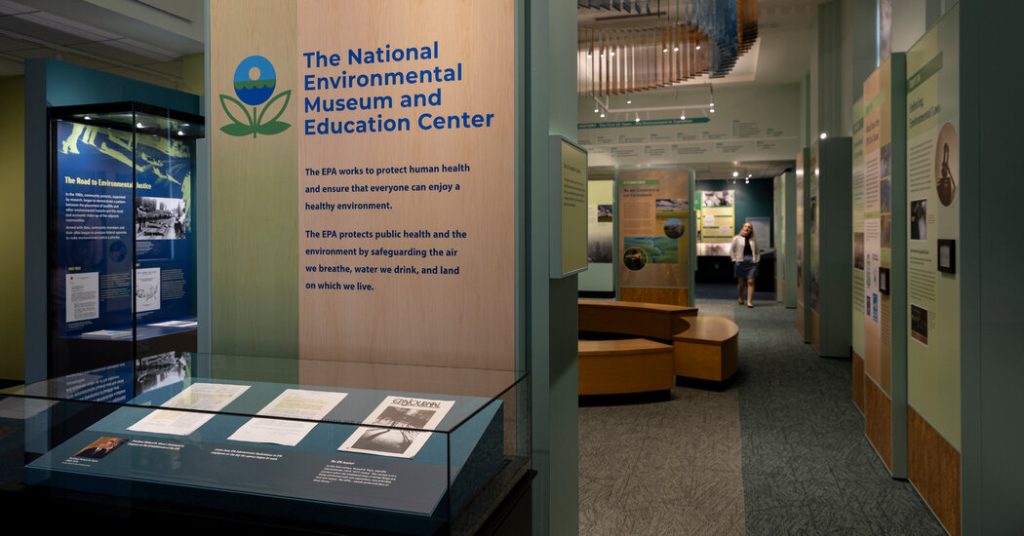The Resilience of the National Environmental Museum and Education Center
In the heart of Washington D.C., where iconic masterpieces and monuments dominate the National Mall, a small, lesser-known museum stands as a quiet testament to the Environmental Protection Agency’s (E.P.A.) mission. Tucked away in the William Jefferson Clinton Building near the White House, the National Environmental Museum and Education Center has managed to remain open despite the turmoil faced by federal agencies under President Trump and Elon Musk’s sweeping cuts. This humble tribute to the E.P.A.’s work in combating pollution and climate change seems to endure, perhaps as a symbol of resilience—or simply because it remains unnoticed by many.
The museum, which opened in 2024, is nestled in a federal building on Pennsylvania Avenue. Its bright, welcoming space contrasts sharply with the drab, temporary exhibit that preceded it. While the museum itself is modest in size, its existence serves as a poignant reminder of the E.P.A.’s critical role in environmental conservation. Yet, with the Trump administration’s threats of massive staff and budget cuts, the museum may soon become a bittersweet symbol of a diminished agency.
A Labor of Love: The Museum’s Creation and Purpose
The idea for the museum was born during a 2015 visit to Japan by Gina McCarthy, then the E.P.A. administrator. Inspired by an environmental museum she toured, McCarthy returned to the U.S. with a vision to create a similar space celebrating the E.P.A.’s work. Stan Meiburg, who served as acting deputy E.P.A. administrator from 2014 to 2017, described the project as a “labor of love.” Enthusiasm for the museum was palpable, with staff and supporters eager to highlight the agency’s achievements in protecting the environment.
Today, the museum tells the story of the E.P.A.’s history, from its creation by President Nixon in 1970 to landmark events like the Love Canal toxic waste crisis and the Deepwater Horizon oil spill. Exhibits also acknowledge grassroots movements, such as the 1982 protest in Warren County, North Carolina, which highlighted environmental injustices in Black communities. These stories are presented in a non-partisan way, emphasizing the universal importance of clean air and water.
However, the museum does not dwell on the agency’s challenges, such as the chronic underfunding of the Superfund program or the controversies surrounding Scott Pruitt, Trump’s first E.P.A. administrator, who resigned in 2018. Instead, it focuses on the progress made and the ongoing need for environmental stewardship.
A Symbol of Resistance in a Time of Turmoil
The museum’s existence is not without irony. Just a short walk away, the former headquarters of the U.S. Agency for International Development was shuttered in January as the first target of Musk’s so-called Department of Government Efficiency. Signs were covered or removed, and employees were left in disarray. Across the executive branch, agencies face similar cuts, along with mandates to eliminate diversity initiatives and scrub mentions of climate change from official communications.
Against this backdrop, the E.P.A. museum stands as a quiet act of defiance. While some may view it as a relic of a bygone era, others see it as a vital reminder of the agency’s mission. State Senator Nate Blouin of Utah, who stumbled upon the museum last summer, expressed his delight at the exhibit celebrating Salt Lake City’s public bike program. “It would be a shame,” he wrote, “to see the work that was already done honoring the country’s environmental achievements be scrapped over political posturing.”
Mixed Signals: The E.P.A. Under New Leadership
Lee Zeldin, the new E.P.A. administrator, has made his priorities clear. A close ally of President Trump with no apparent background in environmental conservation, Zeldin has canceled $60 million in contracts tied to diversity, equity, and inclusion (D.E.I.) initiatives and environmental justice programs. The agency’s new “Powering the Great American Comeback” initiative emphasizes automotive manufacturing, artificial intelligence, and energy production—goals that seem far removed from the E.P.A.’s traditional focus on environmental protection.
Zeldin has also embraced President Trump’s renaming of the Gulf of Mexico as “the Gulf of America” by rebranding the E.P.A.’s regional division. Additionally, he has hired industry figures, including a formaldehyde lobbyist, to top positions within the agency. These moves have raised concerns about the E.P.A.’s ability to fulfill its mission under his leadership.
Despite these challenges, an E.P.A. official expressed cautious optimism. While acknowledging the uncertainty of working under new leadership, the official noted that the new appointees have been less openly hostile than those in other agencies—or even those who served during Trump’s first term. For now, the museum remains a testament to the agency’s enduring purpose.
The Museum’s Quiet Endurance
Visiting the museum is not without its hurdles. The heavy, unyielding entrance door and airport-style security checks create a sense of formality and exclusivity. Once inside, however, visitors are greeted with a narrative that spans decades of environmental history. On a recent afternoon, a group of George Washington University students explored the exhibits, guided by worksheets distributed by their professor. The museum’s story—of progress, struggle, and resilience—unfolded before them like a living timeline.
For Dr. Meiburg, the museum’s former champion, its survival is a matter of bipartisan importance. “You keep this museum because it tells the actual story,” he said. “It’s not a partisan story.” As the federal government undergoes dramatic shifts, the museum remains a steadfast reminder of the E.P.A.’s mission—


